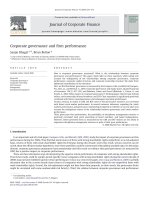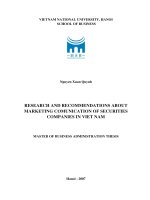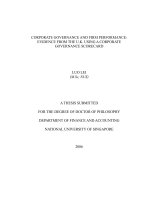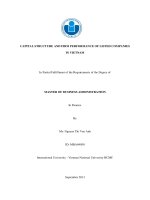The impact of corporate governance on firm performance the case of listed companies in vietnam
Bạn đang xem bản rút gọn của tài liệu. Xem và tải ngay bản đầy đủ của tài liệu tại đây (1.92 MB, 66 trang )
University of Economics
International institute of Social Studies
Ho Chi Minh City, Vietnam
Erasmus University of Rotterdam
The Netherland
VIETNAM- THE NETHERLANDS PROGRAMME FOR M.A. IN
DEVELOPMENT ECONOMICS
THE IMPACT OF CORPORATE GOVERNANCE ON
FIRM PERFORMANCE:
THE CASE OF LISTED COMPANIES IN VIETNAM
By Nguyễn Minh Trí
A thesis submitted in Partial fulfillment of the Requirements for the Degree
of Master of Art in Development Economics
Under the supervision of Dr. Võ Hồng Đức
Vietnam - Netherlands Programme, November 2013
DECLARATION
It is to certify that this thesis entitled “The impact of corporate governance on firm
performance: the case of listed companies in Vietnam” meets all requirements for the
Master Degree of Art in Development Economics. This thesis and all contents presented
in it are developed by me as my own original research. It is neither in part nor in whole
been presented for another degree elsewhere.
Nguyễn Minh Trí
(Author’s name)
.........................................
(Signature)
..............................................
(Date)
The above declaration is affirmed
Dr. Võ Hồng Đức
(Supervisor’s name)
.........................................
(Signature)
.............................................
(Date)
Page ii
ACKNOWLEDGE
First and foremost, I would like to thank my supervisor, Dr. Võ Hồng Đức, an
expert in corporate finance for his advice, guidance and support. My thesis could not be
completed without his invaluable feedback and comment about the theory, data and
research methodology.
I would like to express my sincere gratitude to all lectures of Vietnam –
Netherlands program for their knowledge and provide me opportunity to study this topic.
Special thanks to Dr. Trương Đăng Thụy and Dr. Lê Văn Chơn, who support me
in using econometric models in this thesis.
Furthermore, I would like to thank my friends, who have controversial discussions
with me about my topic and provide some contribution for my thesis.
Last but not least, I would like to send many thanks to my family, who support to
me in both physical and mental extent during my thesis process.
Page iii
ABSTRACT
This empirical research is conducted to examine the relationship between
corporate governance and firm performance. In this study, corporate governance is
proxied by a set of variables, including a dual role of the CEO, board’s size, board
independence and ownership concentration. In addition, firm performance is measured by
four different methods which are (i) return on asset (ROA), (ii) return on equity (ROE),
(iii) Z-score by Altman (1968) and (iv) Tobin’s Q. Using the Feasible Generalized Least
Squares (FGLS) on the dataset of 177 listed companies in Vietnam for the period of 6
years, from 2008 to 2012, the findings of this study indicate multiple effects of corporate
governance on firm performance. First, duality role of the CEO is positively correlated
with firm performance. Second, there is a structural relationship between managerial
ownership and firm performance. Third, board independence has opposite impacts on
firm performance. Fourth, this study however fails to provide an empirical evidence
support the statistically significant relationship between board size and firm performance.
Key words: corporate governance, firm performance, listed companies, Vietnam.
Page iv
LIST OF CONTENTS
CONTENTS
Page
DECLARATION........................................................................................................................... ii
ACKNOWLEDGE ....................................................................................................................... iii
LIST OF FIGURES ................................................................................................................... vii
LIST OF TABLE ....................................................................................................................... vii
LIST OF ABBREVIATIONS .................................................................................................... vii
CHAPTER 1: ................................................................................................................................. 1
INTRODUCTION......................................................................................................................... 1
1.1
Problems statement ................................................................................................................ 1
1.2
Research objectives:............................................................................................................... 3
1.3
Research question: ................................................................................................................. 3
1.4
Research scope: ...................................................................................................................... 4
1.5
Research methodology ........................................................................................................... 4
1.6
The structure of this thesis ..................................................................................................... 4
CHAPTER 2: ................................................................................................................................. 6
LITERATURE REVIEW ............................................................................................................ 6
2.1
Theoretical review ................................................................................................................. 6
2.1.1
Legalistic perspective................................................................................................ 6
2.1.2 Resource dependence ................................................................................................. 7
2.1.3 Class Hegemony ........................................................................................................ 8
2.1.4 Agency theory ............................................................................................................ 9
2.1.5
Stewardship theory.................................................................................................. 11
Page v
2.2
Empirical review .................................................................................................................. 14
2.2.1
CEO duality and firm performance ........................................................................ 14
2.2.2
Board independence and firm performance ........................................................... 17
2.2.3
Ownership concentration and firm performance .................................................... 22
CHAPTER 3: ............................................................................................................................... 28
DATA AND METHODOLOGY ............................................................................................... 28
3.1
Data ...................................................................................................................................... 28
3.2
Variables .............................................................................................................................. 29
3.2
3.2.1
Dependent variables ............................................................................................... 29
3.2.2
Independent variables ............................................................................................. 33
3.2.3.
Control variables .................................................................................................... 35
Methodology ........................................................................................................................ 37
CHAPTER 4: ............................................................................................................................... 39
DATA ANALYSIS AND EMPIRICAL RESULTS ................................................................. 39
4.1
Data statistics ....................................................................................................................... 39
4.2
Results .................................................................................................................................. 44
4.2.1
Empirical results by OLS ....................................................................................... 44
4.2.2
Empirical results by FGLS ..................................................................................... 45
CHAPTER 5: ............................................................................................................................... 50
DISCUSSIONS ............................................................................................................................ 50
CHAPTER 6: ............................................................................................................................... 54
CONCLUSIONS AND IMPLICATIONS ................................................................................ 54
REFERENCES ............................................................................................................................ 56
Page vi
LIST OF FIGURES
Figure 1: Board’s role and attributes ................................................................................. 13
Figure 2: Analytical framework ........................................................................................ 27
Figure 3: Correlation between CEO’s ownership and firm performance ......................... 40
Figure 4: Correlation between Board’s ownership and firm performance ........................ 41
LIST OF TABLES
Table 1: A summary all variables used in this study: concept and measurement ............. 36
Table 2: Descriptive statistic of variables ......................................................................... 39
Table 3: Correlation matrix among variables .................................................................... 43
Table 4: the results by using pooled OLS ......................................................................... 44
Table 5: Tests of heteroskedasticity and autocorrelation .................................................. 45
Table 6: The results by using FGLS .................................................................................. 47
LIST OF ABBREVIATIONS
ROA : Return on asset
ROA : Return on equity
ROI
: Return on investment
CEO : Chief Executive Officer
OLS : Ordinary Least Square
FGLS : Feasible Generalized Least Square
Page vii
CHAPTER 1:
INTRODUCTION
Ho Chi Minh City Stock Exchange (HOSE), established by the Decision 559/QĐTTG of Prime Minister dated 11 May 2013 in Vietnam, was previously considered as the
Ho Chi Minh City Stock Center. Until 2012, HOSE has 342 listed firms including 301
stocks, 3 institutional fund certificates and 38 bonds. Total volume of share and listed
value is more than 26.7 billion shares and 273 trillion VND respectively. The HOSE is
considered as a high liquidity market with total market capitalization of 678 trillion VND
(32.6 billion USD) by the end of 2012. This figure accounted for 24 percent of the
national GDP. Moreover, the average of transaction value in 2012 was 890 billion VND,
an increase of 39 percent compared to that in 2011. During a recent global financial crisis
in 2008/2009, HOSE still achieved positive results. (Source: HOSE’s website)
1.1
Problems statement
Corporate governance focuses on the structures and processes for the business
direction and management of firms. It involves the relationships among company’s
controlling system, roles of its board directors, shareholders and stakeholders.
Williamson (1988) considered that the corporate governance has relation with transaction
cost and, in turn, enhances firm performance. In addition, weak corporate governance
reduces investor confidence and discourages outside investment. Similarly, Bhagat and
Page 1
Bolton (2008) undertook a research on the endogenous relationship between corporate
governance and firm performance and concluded that good corporate governance affects
positively to performance.
For developing countries, board of directors plays an important role in improving
firm performance in order to serve public objectives. In Vietnam, the framework of
corporate governance has just been in an early stage of development. There are not many
laws regulating corporate governance in Vietnam based on different types of companies.
Consequently, some shortcomings occur in corporate governance situation in Vietnam. In
academia, the corporate governance in Vietnam has been approached in many angles of
law and legal consideration by Nguyen (2008), qualitative model by Le and Walker
(2008) and quantitative approach by Vo and Phan (2013a,b,c,d).
Various empirical studies by Vo and Phan can be considered groundbreaking
studies on the examination of the relationship between corporate governance and firms’
performance. In their studies, there is a positive relationship between CEO duality,
experience and compensation to firm performance. However, board’s size and firms’
performance are negatively correlation in their studies. Vo and Phan also concluded that
there is an existence of the nonlinear relationship between board’s ownership and firm
performance. In another study, Vo and Phan (2013) examined the effect of corporate
governance to firms performance through a gender of board members. This study
confirmed the role of female board members to improve firms’ performance. In addition,
Vo and Phan (2013) also introduced a new method in which an interaction of variables
Page 2
between the CEO duality and growth opportunity is considered. Especially, another
study of Vo and Phan (2013) is considered as full version of corporate governance
because it referred most of important elements of corporate governance affecting to firm
performance.
Various empirical studies on corporate governance and firms’ performance in Viet
Nam consecutively conducted by Vo and Phan have confirmed that this important issue
in terms of research and practice has not attracted significant attention of research
community in Vietnam in the past. However, even though Vo and Phan’s studies have
covered a wide range of issues in relation to corporate governance, their estimation for
firms performance is relatively constrained. As a result, the importance of the topic on
corporate governance and a relaxation of restriction on the measurements of firms’
performance has motivated me to conduct this study to provide another empirical
evidence on the issue for a further debate.
1.2
Research objectives:
The objective of this study is to empirically examine the relationship between
corporate governance and firm performance in term of three components: duality, board
composition and ownership concentration
1.3
Research question:
What is the relationship between corporate governance and firm performance?
Page 3
1.4
Research scope:
The impact of corporate governance on financial performance of companies listed
in Ho Chi Minh City Stock Exchange (HOSE) from 2008 to 2012 in Vietnam are
considered. In addition, firm performance in this study is only considered on the ground
of financial performance. As such social performance or economic performance is
beyond the scope of this study. The term “performance” in this study is used to present a
financial performance of firms.
1.5
Research methodology
Economic model: My study conducts the corporate governance through its three
main components: CEO, board composition and ownership concentration. The link
between corporate governance and firm performance was developed by Zahra and Pearce
in their study in 1988. In addition, variables to control firm and industry specification are
also in use.
Econometric model: The Feasible Generalized Least Square (FGLS) is used to
examine the relationship between corporate governance and firm performance.
1.6
The structure of this thesis
The thesis contains six chapters which are arranged as follows:
Chapter 1 provides an overview on the thesis including reasons for selecting the
topic, research question, research scope, data and methodology. Chapter 2 is devoted for
Page 4
a literature review. This chapter explores the theories explaining the mechanism of
impact of corporate governance on firm performance. In addition, results of selected
empirical studies are also considered. This chapter provides the readers with an
understanding on a theoretical and empirical framework adopted in this study.
Chapter 3 presents data and methodology. This chapter also discusses how data
are collected and variables are measured. An empirical model to examine the link
between corporate governance and firm performance is also presented Following this
chapter, Chapter 4 discusses empirical findings of this study
The final two chapters, 5 and 6, are devoted to the discussions and conclusions and
implications. Based on theories presented in Chapter 2 on the literature review, Chapter 5
discusses the effects of corporate governance on firm performance in Vietnam from 2006
to 2012. The final chapter presents a summary of main findings of this thesis, and
presents limitations; and provides implications for firms in Vietnam.
Page 5
CHAPTER 2:
LITERATURE REVIEW
2.1
Theoretical review
In corporate governance, board of director is considered as the most important
factor which affects an entire business and interest of owners. As such, the question of
“what is the board of director characteristics and how does it influence financial
performance of a firm” has attracted significant attention from academia and practitioners
over the last 50 years or so. Zahra and Pearce (1989) in their research approached the role
of board of director on financial performance by reviewing and synthesizing four
perspectives: (i) legalistic perspective, (ii) resources dependence, (iii) class hegemony;
and (iv) agency theory. Meanwhile, stewardship theory, which is developed by Davis,
Schoorman and Donaldson (1997), explained the board’s role in different way.
2.1.1 Legalistic perspective
Zahra and Pearce (1989) defined corporate governance as the contribution of four
factors including board composition, characteristics, structure and process. First, board
composition refers to the size of the board and the mix of inside and outside directors.
Second, characteristics include experience, independence, ownership and others relating
to the benefits and tasks of directors. Third, structure is defined as the way to organize the
board and finally, process is involved all activities related to decision-making. This
theory also indicated that the efficiency of board director is determined by two primary
Page 6
factors known as service and control: improving company reputation, cooperating with
external environment; and ensuring sustainable corporate growth rate and serving
shareholder’s interest. These two roles depend on ownership concentration and firm size.
The ownership concentration refers to the size of owners which impact to the survival
and firm’s wealth. For firm size, small companies only require simple corporate
governance but the larger will need more complex function from management. Therefore,
when empirical studies on corporate governance are conducted, firm size is usually used
as control variable.
2.1.2 Resource dependence
This perspective was developed based on sociological and organizational theory.
Zahra and Pearce (1989) pointed out that the directors play an important role on helping
company handle general and competitive environment. The advantages which directors
bring to firms are reducing uncertainty in business, improving company reputation in
society and decreasing transaction cost. The functions of directors are usually laid on
“service” and “control” because the strategy function is developed by the CEO.
Resources dependence perspective also indicated that board performance is subject to
three contingencies: (i) external environment, (ii) company circle life and (iii) type of
firm. The impact of the board on financial performance occurs inside the company
through the influence on strategic initiatives by creating the concept and framework for
good business. However, this perspective has some limitation. First of all, it does not
refer to the link between directors and strategic development. Next, the dynamic power is
Page 7
not focused on in researching the composition and change of the board. Last but not least,
the board of director is designed rather simply but in reality, it is generally not the case.
Hillman and Dalziel (2003) presented that resources dependence theory is also
crucial path exploring the impact of the board on firm performance. This is considered as
board ability including board capital (experience, knowledge, reputation) and relational
capital (social network, external relationship with other institutions). Resources
dependence impacts on firm performance through increasing the strong relationship
between organization and external contingencies, decreasing transaction cost and
rejecting uncertain situation. All functions of board ability will be done across variety of
specific activities including improving firm’s image in public, connecting firm to external
institutions, utilizing access of optimal capital. Therefore, provision of resources leads to
better performance.
2.1.3 Class Hegemony
Class Hegemony considers board process as important factor affecting financial
performance. Similarly with legalistic approach, Zahra and Pearce (1989) presented that
board process is an important variable in studying on the relationship between board of
director and firm performance. According to this theory, service and control depend on
ownership concentration, CEO power and style. CEO is considered as the most important
person serving the board. From this view, the CEO and board of director develop the
strategy to ensure that high performance in finance and system and consistency between
the sake of CEO and owners are met. However, this perspective also contains some
Page 8
limitations. First, it lacks of specific evidences in exploring how the board enhances
company performance. Second, Class hegemony does not test real corporate governance
practices. Finally, the change in corporate ownership patterns is not considered although
it is very important in large company.
2.1.4 Agency theory
This theory is considered as dominant one to explain the role of board directors on
financial performance. Zahra and Pearce (1989) reviewed some papers and synthetized
them into main rule in order to explore this relationship. In term of agency theory, the
principal and agent are shareholders and directors respectively. The paper presented that
there is inconsistency between the benefit of owners and managers based on the attributes
of four characteristics like legalistic perspective. However, agency theory focuses more
on “process” factor rather than the other. Roles of the board are also presented through
three contingencies as control, service and strategy. However, differently from resources
dependence, “control” function receives mostly attention from agency theorists. Though
this is the most popular theory in explaining the role of board, it has still occurred three
shortcomings. First, this context assumes that CEOs follow their own interest more than
the shareholder’s wealth. Second, agency theory has just focused on “control”
characteristic of board and ignored the “service” and “strategy”. Third, this perspective
highlights the board strategic and does not refer to role of CEO in making decision and
strategy of company. It is easy to cause the failure in controlling and reducing firm
performance.
Page 9
Having similar view with Zahra and Pearce (1989) on agency theory, Davis,
Schoorman and Donaldson (1997) indicated more clearly that agency theory refers to the
conflict between the goal of principal as owners and agent as managers. In a particular
company, shareholders allocate their wealth on investing on the asset of corporations and
they authorize managers to operate the relevant firms. The principal has tendency to
maximize the utility of shareholder in the long- run. By contrast, the agents usually
operate firms for their individual interests. This perspective also pointed out that the
solution for this problem is integrating the principal-agent benefits and minimizing the
agency cost. For first solution, in term of financial scheme, is that the company needs
reward and punishment policy which aligns the interests of shareholders and managers.
Second, in term of governance structure, owners must diversify the management board by
using outsiders. Therefore, independent directors play an important role on increasing
firm performance and maximizing shareholder’s wealth. Pfeffer (1972) indicated that
most companies meet the change in business environment is changing size and board
composition measured by percentage of outside directors and ownership. The percentage
of outside director helps firms attract outside capital which also influences the firm
performance. With external capital, the firm can take advantage of cheaper capital from
the outside and reduce cost. In addition, organizational environment is also reflected
through size of board. The advantages of larger size board are first, more diversified in
handling problems and second, increasing the impact of company to society due to the
relationships of members in board. Therefore, firms with many directors will exploit
Page 10
more resources from the outside than the others in order to make their performance
better.
Hart (1995) illustrated that the board plays a crucial responsibility in firms but
there are some reasons for the effectiveness of its in practice. He again confirmed in his
study that the board of directors affects to financial performance. However, the
effectiveness of directors is subject to board independence. In reality, there are two kinds
of director in the board: executive and non-executive director. Executive directors are
inside manager who may be employee, supplier or the previous owner of company. The
latter is usually considered as independent manager who has no relation with companies.
On the one hand, as agency theory indicates, executive directors are expected to monitor
effectively. On the other hand, the non-executive directors may not be good at controlling
the firms for some reasons. First, there is an inconsistency for the interest between
companies and outside directors. They work for salary or compensation. Second, nonexecutive directors may be busy because they may be director of many companies at the
same time. Therefore, they may not focus on operating firms effectively.
2.1.5
Stewardship theory
In contrast to agency theory, Davis, Schoorman and Donaldson (1997) examined
the new approach to the relationship between the benefit of shareholders and managers,
which is developed based on psychological and sociological concepts. The interests of
individual and organization are mixed and managers operate companies to maximize
utility. The cooperative behaviors are not traded off for self-behaviors because, in term of
Page 11
stewardship theory, the thinking and activities of directors are consistent of the
performance of companies. Therefore, the steward seeks to get the objectives and
development of firms. The differences between the stewardship and agency are that the
agency theory focuses on extrinsic satisfaction which can be measured by market value
and the other refers to intrinsic satisfaction which can be motivation, achievement or
reputation. Moreover, the manager in stewardship perspective realizes that by working
for the high performance of organization, the personal utility can be met. Additional new
information from this theory is focusing on the role of structure rather than the monitor
and control. Particularly, stewardship concepts consider structure of the board affecting
the financial performance significantly. Donaldson and Davis (1991) illustrate there is the
positive relation between the utility of principal and agent. This study proves that the
CEO as chairman will make financial performance of a firm better.
The stewardship theory and agency theory are tested in network connections by
Muth and Donaldson (1998). The network is defined as contribution of external
organization, co-director link, director link and external director link. Consequently, the
stewardship theory believes that the managers with strong external connection highly
associate firm performance. Whereas, agency theory just focuses on internal connection
and take the conflict between directors and shareholders as central problem which affects
firm value. Agency theory refers to large board size and high independent board to
increase firm performance whereas; stewardship theory is in favor of small board size
and inside directors which have positive effect on sale growth and shareholder wealth.
Page 12
Besides, this study also pointed out that it should not research independence of the board
by individual variable because it causes bias in measurement. Board size and composition
also reflect the organizational performance and internal and external environment.
In summary, the roles and attributes of board of directors is integrated by Zahra
and Pearce (1989) through reviewing four perspectives: legalistic perspective, resources
dependence, Class hegemony and agency theory. The conceptual framework of
relationship between the board and firm performance is showed as follow:
Figure 1: Board’s role and attributes (Source: Zahra and Pearce (1989))
Internal contingencies
Business circle
CEO style
Company size
Corporate resource situation
Process
Meetings
CEO-board interface
Consensus
Evaluation
Formality
External contingencies
Environmental variables
Industry style
Legal requirement
Board structure
Committees
Organization
Flow of information
Leadership
Board
characteristic
Background
Personality
Board composition
Size
Outsider and insider
Minority
Board rules
Service
Strategy
Control
Financial
performance
Page 13
2.2
Empirical review
2.2.1 CEO duality and firm performance
The role of CEO-chair person is also clarified by Rechner and Dalton (1991)
through longitudinal analysis. They conducted their study in two group companies having
a change in board of director and how it affects corporate performance. The study pointed
out that there is significant difference in return on investment (ROI), return on equity
(ROE) and profit margin between CEO duality firms and those with independent
directors. In general, the performance in case of independent directors is higher than that
in duality through two dimensions. However, the variance of those returns in duality
companies is more stable than the other. Moreover, this research only focuses on one
independent variable – board chairperson regardless specifications of firms such as firm
size, ownership structure.
Daily and Dalton (1994) had one research on the impact of board composition and
structure on bankruptcy. This work studies many factors relating to board of director
including director’s ownership, independence of board and CEO, CEO characteristics and
structure of ownership (individuals and institutions). Using logistic regression, this study
presented the probability of bankruptcy in two cases of duality structure and affiliated
directors. The results reflect the status of corporate governance structure in five years
before going bankrupt. It is suggested that probability of bankruptcy in duality firms is
lower than that in firms using affiliated directors. Although this study does not explore
Page 14
the impact of CEO duality, the result is promising because of prediction of the influence
of corporate governance to firm performance.
However, Baliga, Moyer and Rao (1996) who studied the relationship between
duality and firm performance presented opposite results. First, in this study, there is no
significant difference in operating performance when the change in duality status occurs.
The reasons for this are there is no amazing in announcing information of new status into
public, so the value of company cannot be affected. Second, in the long term, there is no
significant difference in impact of duality and non-duality on firm performance. This
paper also indicated that although the duality makes the managerial process change, it
does not create more assets and affects to financial performance. The main finding of this
research is very absolutely important for increasing value of company through improving
governance because complexity of determinants which affect to performance.
The direction and magnitude of duality-performance relationship are again argued
in study of Boyd (1995). The author used contingency model to test two theories: agency
theory and stewardship theory and presented that the effect of chair directors on financial
performance is very different across various environments. The kinds of environment are
separated in three sectors: munificence, dynamism and complexity. The munificence
which measures the available level of resources supporting to industry prevents firms
from uncertain situation. Dynamism reflects changing degree of environment and
complexity measures inequalities among competitors. Boyd (1995) suggested that there is
an occurrence of incompletion and misleading in both of agency theory and stewardship
Page 15
theory. However, through the effect of uncertainty environment, CEO duality has highly
positive association with performance in low munificent and high complex environment.
The relation between CEO-chair duality and firm performance was studied by
many economists. Bhagat and Bolton (2008) took into account the relationship between
duality and financial performance in correlation with board size, stock ownership of
board members as measurements of corporate governance and return on asset (ROA),
stock return and Tobin’s Q as corporate performance. By using regression method
including Ordinary Least Square (OLS), two stage least square and three stage least
square, the authors proved that CEO-duality separation has positive association to firm
performance.
Abidin, Kamal and Jusoff (2009) approached corporate performance in different
way. For financial performance, it is defined as the value added (VA) efficiency
calculated through Value Added Intellectual Coefficient methodology (VAIC). This
figure is a composition of capital efficiency, human capital efficiency and structural
capital efficiency. In addition, the research also included some variables: profitability,
leverage, dividend yield, research and development sensitivity and firm size to control
firm specification. By using regression methodology, this study presented that coefficient
of CEO duality is insignificant. This means that there is no difference value added
efficiency between companies that practices duality and separate CEO and chairman.
Judge, Naoumova and Koutzevol (2003) indicted opposite conclusion of relation
between duality and firm performance. This research which is studied with small firms in
Page 16
Russia indicated adverse influence of informal CEO duality and proportion of inside
director on performance. The authors used the term “informal” because Russian law does
not permit the CEO which is also chairman in one company. One new finding in this
research is the role of retrenchment activity on corporate governance. The entrenchment
activity reduces the impact of CEO duality on performance and causes negative
relationship between inside director and firm value. The limitation of this paper is not
conducted on a sample including large companies.
2.2.2 Board independence and firm performance
Klapper and Love (2004) presented their research about corporate governance and
performance on 495 firms across 25 emerging markets. They create one yes-no question
list and set criteria to measure quality of corporate governance relating to discipline,
transparency, and independence of the board, accountability, responsibility of board
members, fairness and social awareness. Each question is constructed such binary score:
one point added to governance score for answer “yes” and zero for answer “no”. For firm
performance, Tobin’s Q and ROA are used to represent firm value and operating
performance. This study not only ranked corporate governance level but also studied the
relationship between corporate governance and firm performance. The main findings
indicated that (1) in countries having weak legal environment, the governance ranking is
lower; (2) the governance level is subject to asymmetric information, imperfect problems;
(3) listed companies have higher rank than the others; (4) the firm performance proxied
by market value and operation is positively associated by good governance and; (5) in
Page 17
strong legal system, this relation is weaker. The explanation for this result is that for the
countries with inefficiency in law and poor protection in shareholder’s wealth, the
governance quality is one problem because few terms regulate activities of the board.
However, for better governance, it seems the weak legal system does not affect
governance in improving firm performance because the well-governed firms may need
less legal system in handling conflict. The results of this research add an important
implication in managing firm. The firm should focus on governance regardless poor legal
situation in order to enhance firm performance
One research is done by Daily and Dalton (1992) on the impact of governance
structure proxied by role of CEO, board composition on firm performance. By using
contingency and multivariate analysis of variance model to analyze 100 small listed
companies in the United States, this study indicated some interesting conclusions. First,
in case of CEO being also founder of company, there is no evidence to support the
association of duality, fewer outside directors and lower proportion of outside directors
on firm performance. Second, in case of CEO not being founder of company, CEO
duality still associates insignificantly to firm performance. However, few outside
directors cause lower performance through ROA and ROE ratios. This result also pointed
out that the higher proportion of outside directors brings the good performance to
companies. The authors suggested that the advantage of outside directors is contributing
to the firm more service, resource access and controlling roles. This explanation bases on
Page 18
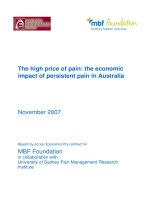


![brown, caylor - 2006 - corporate governance and firm performance [cgs-gov-score]](https://media.store123doc.com/images/document/2015_01/02/medium_odt1420194779.jpg)
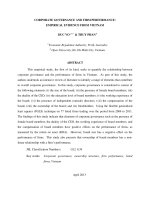
![brown, caylor - 2006 - corporate governance and firm performance [cgs-gov-score]](https://media.store123doc.com/images/document/2015_01/06/medium_dhs1420548411.jpg)
